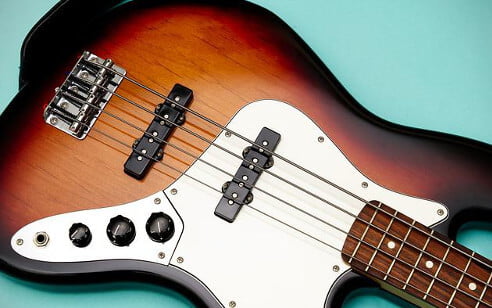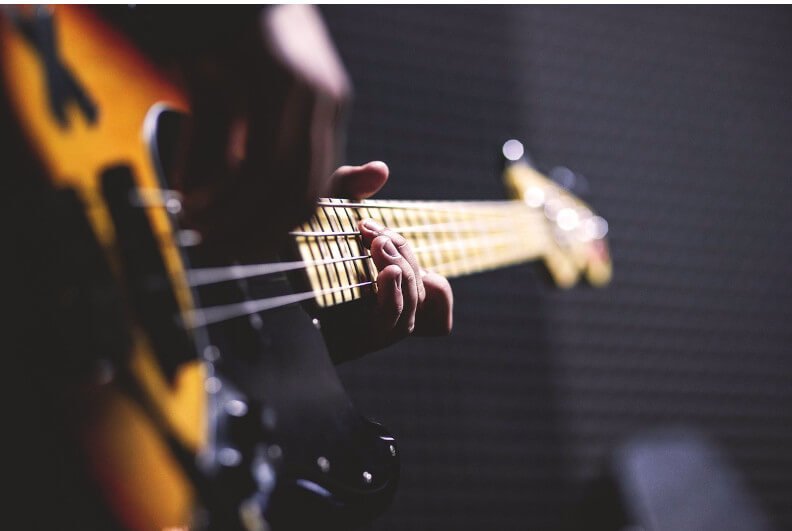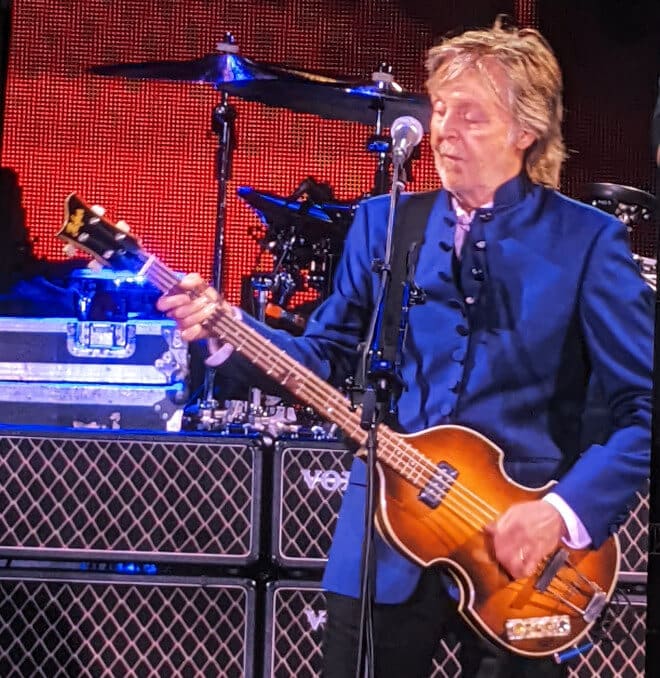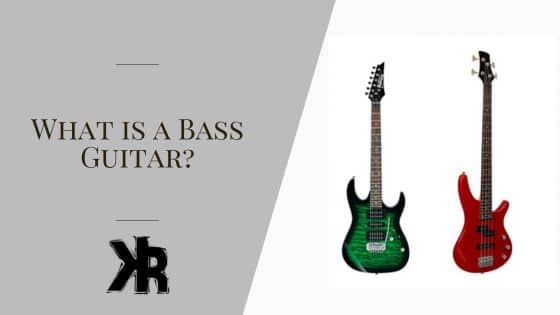Table of Contents
Have you ever found yourself tapping your foot or nodding your head along to the beat of a song? That infectious rhythm you can’t help but move to is often driven by the unsung hero of the musical world, the bass guitar.
This versatile instrument not only provides the foundation for many popular music genres, but also boasts a fascinating history and a plethora of playing styles.
Unraveling the mysteries behind its unmatched rhythm is a great way to explore the possibilities. Whether you’re a passionate music lover or an aspiring bass player, I’m here to walk you through all there is to know about this essential musical instrument.
What is a Bass Guitar?
A bass guitar is a stringed musical instrument that produces low-frequency sounds. Typically, lower than those of a standard electric or acoustic guitar.
Designed to provide the rhythmic and harmonic foundation in a musical ensemble, bass guitars play a crucial role in shaping the overall sound and feel of a piece.
They generally have four strings. Although variations with five, six, or even more strings exist to accommodate different playing styles and extended ranges.
The strings are tuned to the standard notes E, A, D, and G. This is an octave lower than the four lowest strings on a standard guitar.
History of the Bass Guitar
The origins of the bass guitar can be traced back to the orchestral double-bass. A large, upright stringed instrument that dates back to the 15th century.
The double bass provided the low-frequency foundation in orchestral music. But its size and portability issues made it less than ideal for many musical settings.
The quest for a more portable and practical solution led to the invention of the electric bass guitar. Paul Tutmarc, an American musician and inventor, created the first electric bass in the 1930s.
However, it was Leo Fender, the iconic guitar maker, who popularized the instrument with the introduction of the Precision Bass in 1951.
This revolutionary design transformed the bass into a horizontal, solid-body electric instrument that was far more portable and user-friendly than its predecessor.
The Fender Precision Bass, affectionately known as the P-Bass, quickly gained popularity among musicians. Especially those who embraced its new-found portability and versatility.
The 1960s saw the emergence of the Fender Jazz Bass, another iconic model that offered a different tonal palette and improved playability.
With time, the bass guitar has undergone numerous transformations in terms of its design, dimensions, and arrangements.
These progressive modifications have broadened the instrument’s potential, empowering bass players to get into fresh aural landscapes and methodologies.
Today, the bass guitar is a staple in countless music genres! Providing the rhythmic and harmonic backbone that keeps us grooving to our favorite tunes.

Anatomy of a Bass Guitar
Grasping the different components that constitute a bass guitar is crucial for anyone who aspires to become a bassist or has a passion for music.
The structure of a bass is akin to that of a standard guitar, albeit with variations in areas like scale length, string thickness, and electronics. Let’s dissect the parts to develop a more profound comprehension of this beat-driven instrument.
Headstock
The headstock is the uppermost section of the bass guitar, positioned at the termination point of the neck. Its chief role is to accommodate the tuning pegs, which are instrumental in modifying the tightness of the strings and tuning the instrument.
The architecture of the headstock can differ greatly among different brands and models, with some showcasing original forms and brand logos.
Tuning Pegs
The tuning pegs, also known as machine heads or tuners, are mounted on the headstock and used to fine-tune the pitch of each string. They consist of a geared mechanism that allows for precise adjustments to the string tension, ensuring the instrument stays in tune.
Nut
The nut is a small, grooved piece located at the junction of the headstock and the neck. It’s typically made of bone, plastic, or synthetic materials and is responsible for maintaining the correct spacing and height of the strings as they pass over the fretboard.
Neck
The bass guitar’s neck is an elongated, narrow segment that bridges the body and the headstock. Typically constructed from wood types like mahogany or maple, it accommodates the fretboard, frets, and truss rod.
For optimal playability, the neck’s rear is contoured into different shapes such as the C-shape, U-shape, or V-shape.
Fretboard
The fretboard, also known as the fingerboard, is a thin layer of wood, usually rosewood, maple, or ebony, that is attached to the neck’s surface.
It features metal frets, which are thin strips embedded at specific intervals to divide the fretboard into semitone increments. The fretboard is where the player’s fingers press down on the strings to produce different notes.
Frets
Frets are the metal strips embedded in the fretboard that help define the pitch of each note. When a player presses a string down behind a fret, the length is effectively shortened, raising its pitch. The number of frets on a bass guitar can vary. But most models have between 20 and 24 frets.
Body
The primary, substantial part of a bass guitar that accommodates the pickups, bridge, and electronics is known as the body. It’s typically crafted from woods like alder, ash, or mahogany. The body’s form and size can vary, reflecting the design preferences of different manufacturers and models.
In most cases, the body of an electric bass guitar is solid. On the other hand, an acoustic variant of a bass guitar possesses a body that is hollow.
Pickups
Pickups are electromagnetic devices mounted on the body of the bass guitar beneath the strings. They convert the strings’ vibrations into electrical signals, which can then be amplified and reproduced as sound.
Bass guitars often have one or more pickups, with different designs like single-coil, humbucker, or piezo, each offering a certain tonal characteristic.
Bridge
The bridge is the component mounted on the body that anchors the strings and transfers their vibrations.
It also allows for adjustments to the strings’ height and intonation, ensuring accurate pitch and comfortable playing action.
Types of Bass Guitars
Bass guitars come in various shapes, sizes, and configurations. Each with its own characteristics, sound, and application.
By understanding the different types, you can choose the right instrument for your playing style and musical preferences. Let’s take a look at some of the most common types available today.
Electric Bass Guitars
Electric bass guitars are the most common type and rely on electronic amplification to produce sound. They feature solid bodies made of materials such as alder, ash, or mahogany and come equipped with magnetic pickups that capture the strings’ vibrations.
The pickups then convert them into electrical signals. Electric bass guitars are popular for their versatility, playability, and wide range of tonal options.
Precision Bass
The Fender Precision Bass, or P-Bass, is the first mass-produced electric model and remains a popular choice for its iconic sound and comfortable playability.
It typically features a split-coil pickup, providing a deep, warm, and punchy tone that works well in various music genres.
Jazz Bass
The Fender Jazz Bass, or J-Bass, is another widely-used electric model known for its slim neck profile and versatile tonal options.
It features two single-coil pickups that can be blended together to produce a wide range of sounds. All from smooth and mellow to bright and aggressive.
Acoustic Bass Guitars
Acoustic bass guitars have hollow bodies and produce sound through a soundhole. Very similar to an acoustic guitar.
These versions can be played without amplification. Although, their volume is typically lower than that of an electric model.
Many acoustic bass guitars also come with built-in pickups and preamps. This allows them to be plugged into an amplifier or PA system for increased volume and tonal control.
Semi-Acoustic Bass Guitars
Semi-acoustic bass guitars are also known as hollow-body or semi-hollow. They combine elements of both electric and acoustic bass designs.
They feature a partially hollow body with a solid center block, which reduces feedback issues while still providing some acoustic resonance. Semi-acoustic bass guitars often have a warm, and woody tone that is favored by many jazz and blues musicians.
Extended-Range Bass Guitars
Extended-range bass guitars have more than the standard four strings, allowing for greater pitch range and versatility.
Common extended-range models include five-string models, which add a lower B string. And six-string bass guitars, which add both a lower B and a higher C string.
These instruments are popular among bassists who require additional range for soloing or playing in genres such as progressive rock, jazz, and metal.

Sound of a Bass Guitar
The sound of a bass guitar is a defining factor in the overall sonic landscape of a piece of music. It provides the rhythmic and harmonic foundation upon which melodies and other instruments are built.
They can produce a wide range of tones, textures, and dynamics, making them a versatile and expressive instrument that can adapt to various musical genres.
The sound of a bass guitar is influenced by several factors. This includes the type, the materials used in its construction, the electronics, and the playing techniques employed by the musician.
Let’s explore how these elements contribute to the wonderful voice of the instrument.
Model Characteristics
Different types of bass guitars produce certain sounds. For example, a P-Bass is known for its deep, warm, and punchy tone, while a J-Bass offers a more versatile and articulate sound.
Acoustic bass guitars produce a natural, resonant tone. Whereas semi-acoustic models combine the warmth of an acoustic instrument with the clarity and sustain of an electric.
The materials used in the construction of a bass also impact its sound. The type of wood used for the body, neck, and fretboard can influence the instrument’s tonal qualities, sustain, and resonance.
For instance, a model with a mahogany body typically has a warm, full-bodied sound. While one made from alder or ash might produce a brighter and more focused tone.
Electronics and Amplification
The choice of pickups and electronics plays a significant role in shaping the sound of a bass guitar. Single-coil pickups tend to produce a bright and clear tone.
While humbuckers offer a fuller, warmer sound with reduced noise. Active electronics, which require a battery, provide additional tonal control and output. While passive electronics rely on the natural character of the instrument.
Amplifiers and speaker cabinets also contribute to the overall sound of a bass guitar. Different amplifier designs, such as tube, solid-state, or digital, can impart their own sonic characteristics to the instrument.
Similarly, the size and configuration of the speaker cabinet can affect the frequency response and projection.
Playing Techniques
The way a bassist plays the instrument has a significant impact on its sound. Different playing techniques, such as fingerstyle, slap, or using a plectrum, each produce their a certain tone and texture.
For example, fingerstyle playing can create a warm, round sound, while slapping offers a more percussive and aggressive tone.

Popular Music Genres That Use Bass Guitars
The bass guitar is an incredibly versatile instrument that can be found in a wide variety of music genres.
Its ability to provide the rhythmic and harmonic foundation makes it an indispensable component in many styles. Here are some popular genres that prominently feature bass guitars.
Rock
Rock music, with its roots in the 1950s and 1960s, is one of the most prominent genres to utilize the bass guitar.
The instrument’s powerful low-end and driving rhythm play a key role in defining the sound of rock bands. From classic acts like The Beatles and Led Zeppelin to modern groups such as Foo Fighters and Red Hot Chili Peppers.
Jazz
Jazz, a genre known for its improvisation and complex harmonies, has embraced the bass guitar as an essential part of its sonic palette.
While the double bass was initially the instrument used in jazz, many musicians have since transitioned to the electric version for its portability and diverse tonal options.
Jazz bassists like Jaco Pastorius and Stanley Clarke have showcased the instrument’s capabilities and contributed to the evolution of the genre.
Funk
Funk music, characterized by its infectious grooves and syncopated rhythms, relies heavily on the bass guitar to drive its signature sound.
Iconic funk bassists like Larry Graham and Bootsy Collins pioneered techniques such as slap bass. This involves percussively striking the strings to produce a rhythmic tone that defines many funk classics.
Reggae
Reggae, a music genre originating in Jamaica, features the bass guitar as a crucial component of its laid-back and rhythmic sound. The basslines in reggae often play a more melodic and prominent role than in other genres.
Providing both the harmonic foundation and the central groove. Influential reggae bassists like Aston Barrett have shaped the genre’s sound with their innovative playing styles.
Pop
Pop music, known for its catchy melodies and wide appeal, frequently employs the bass guitar to provide the rhythmic backbone of its songs.
Basslines in pop music can range from simple and supportive to intricate and melodic, showcasing the instrument’s adaptability across various styles and artists.
Metal
Metal, a genre characterized by its aggressive sound and complex arrangements, also heavily relies on the bass guitar.
The instrument’s low-end power and extended range, especially in five- or six-string basses, contribute to the genre’s dense and heavy soundscapes.
Metal bassists like Cliff Burton and Steve Harris have demonstrated the instrument’s ability to drive the intensity and intricacy of metal music.
Renowned Bassists
Throughout the history of modern music, numerous bassists have made their mark with their unique playing styles, innovative techniques, and memorable basslines.
These musicians have not only shaped the sound of their respective genres, but also influenced countless aspiring players. Let’s take a look at some of the most renowned bassists in the music world.
Paul McCartney
As the bassist for The Beatles, Paul McCartney contributed to the foundation of rock music with his melodic and inventive approach to the low-end.
His playing style, which often featured counterpoint and harmony, helped redefine the role of the bass in popular music and set a new standard for future generations of musicians.

Jaco Pastorius
Widely regarded as one of the most influential bassists of all time, Jaco Pastorius revolutionized the way the electric bass was played. Known for his virtuosic technique and fretless bass sound.
Jaco’s groundbreaking work with Weather Report and as a solo artist left a lasting mark on the jazz and fusion genres.
James Jamerson
James Jamerson, the uncredited bassist on countless Motown hits, played a pivotal role in shaping the sound of popular music in the 1960s and 1970s.
His innovative playing, characterized by intricate syncopation and melodic basslines, has inspired generations of musicians. Thus, earning him a place among the most revered bassists in history.
Geddy Lee
As the bassist and vocalist for the progressive rock band Rush, Geddy Lee is known for his intricate basslines, technical prowess, and recognizable tone.
His ability to navigate complex arrangements while simultaneously singing and playing keyboards has solidified his reputation as a multifaceted and highly skilled musician.
Flea
Michael Balzary, better known as Flea, is the bassist for the Red Hot Chili Peppers and has become synonymous with the slap technique. His energetic playing style, combining elements of funk, punk, and rock, has contributed to the band’s sound. This has made him one of the most recognizable bassists in modern music.
Conclusion
The bass guitar, with its ability to provide the rhythmic and harmonic foundation, is an essential and versatile instrument that continues to shape the world of music.
Its rich history, various types, and clear sound have contributed to its prominent role in the music world. All while, famous bass guitarists have showcased its limitless potential through their innovative playing styles and techniques.
No matter who you are, understanding the anatomy, tuning, and maintenance can help you unlock its full potential and enhance your playing experience.
FAQs
How often should I change the strings on my bass guitar?
The frequency with which you should change your bass guitar strings depends on several factors. Such as how often you play, your preferred sound, and the type of strings you use.
As a general guideline, if you play regularly (several times per week), you might consider changing your strings every 3 to 6 months. However, if you prefer a brighter, articulate tone, you may choose to change your strings more frequently.
Keep in mind that coated strings tend to last longer than uncoated strings, but they may have a slightly different feel and sound.
Can I learn bass guitar without any prior musical experience?
Absolutely! While having prior musical experience, such as playing another instrument or understanding music theory, can be helpful. But it’s by no means a requirement to learn bass guitar.
Many beginners start with no prior experience and still find success in learning the instrument. Like any other skill, learning this instrument requires dedication, patience, and consistent practice.
Starting with a beginner-friendly instrument, following a structured learning program, and seeking guidance from experienced players or teachers can help you build a strong foundation. One that will help you enjoy the process of learning bass guitar.

